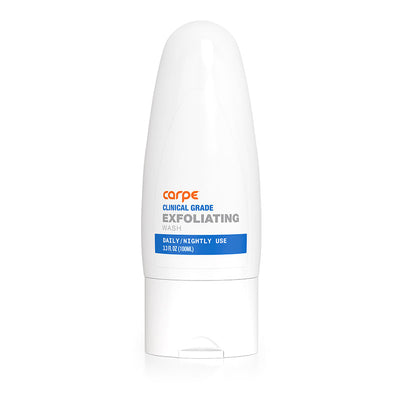What Are Antiperspirant Wipes?
In short, antiperspirant wipes are a new, convenient method of applying antiperspirant to the body - in order to reduce excessive sweating. They allow users to apply antiperspirant quickly, effectively, discreetly, and with less mess. There are a few different types of wipes that hyperhidrosis sufferers can take advantage of, and which type a person should use depends on their specific needs. Each wipe is contained in its own packet and can be stored easily in a pocket, wallet, or purse. A person just needs to open the wipe and apply it to their affected body area. So far, there are two brands that have dominated the antiperspirant wipe market - Carpe and Dermira. Both companies have antiperspirant wipes that are effective in reducing excessive sweating, but they occupy quite different niches in the market. Below is a break down of each product and how they compare.
Carpe Antiperspirant Wipes
Carpe antiperspirant wipes offer a convenient over-the-counter solution to excessive sweating problems. The wipes contain a clear antiperspirant solution that uses 15% Aluminum Chlorohydrate as an active ingredient.[1] Many people aren’t sure how to choose the right over-the-counter antiperspirant, but customers can rest assured as Aluminum Chlorohydrate is a common, time-tested antiperspirant ingredient. It works by forming a shallow plug inside sweat glands which prevents sweat from escaping to the surface of the skin. This effectively reduces the amount of sweat that a person produces and decreases the symptoms of hyperhidrosis.[2] While Carpe antiperspirant wipes are ideal for underarm use, one of the great features they offer is that they are able to be used safely on most parts of the body. This is a major advantage as many people with hyperhidrosis also deal with excessive sweating on hands, feet, and other problem areas.
Many times, antiperspirant can be irritating, but Carpe antiperspirant wipes contain ingredients, like vitamin E oils, that help soothe sensitive skin. This feature makes the wipes more versatile. Carpe antiperspirant wipes are also easy on clothing as they do not leave a white residue behind. Instead, the formulation goes on clear which makes it much easier to keep shirts clean.[1] Many people with hyperhidrosis can attest to the fact that it can be difficult to get traditional antiperspirant out of clothes, so having a clear solution is a massive convenience. In addition to its antiperspirant properties, Carpe antiperspirant wipes also contain fragrances to dispel any bad smells that may emerge from sweaty areas, and a natural antibacterial agent to cut down on bacteria.[1]
Qbrexza Wipes
Qbrexza is a type of prescription antiperspirant wipe formulated by the company Dermira. Unlike traditional topical antiperspirants, Qbrexza uses an active ingredient called Glycopyrronium Tosylate.[3] This active ingredient is the topical form of an anticholinergic medication, which is commonly used as oral medication for hyperhidrosis. In its pill form, anticholinergic medications can have many systemic side effects which often deter people from using them to treat hyperhidrosis, but in its topical form many of the benefits are still present without the systemic issues. Glycopyrronium Tosylate works by inhibiting sweat gland activation and thus reduces the amount of sweat a person produces due to overactive sweat glands. Qbrexza is FDA approved, but only for use on the underarms. As it is a prescription medication its use can have some serious side effects like skin irritation, dry mouth, blurred vision, and others.[3]
Typically, Qbrexza is used once a day and is applied directly to the armpits. This makes it convenient and easy to use. It is most advantageous to people with severe hyperhidrosis who have tried other antiperspirant treatments and have not had success. It can also be used on children older than nine, which gives it an advantage over other FDA approved hyperhidrosis treatments as most cannot be used on children.[3] Qbrexza is a prescription medication, so it should be used with caution, but it can provide hope for those who haven’t had success with less powerful medications.
The Difference Between Carpe And Qbrexza Antiperspirant Wipes
While both types of antiperspirant wipes may appear similar at first glance, they are quite different. Carpe antiperspirant wipes are a type of over-the-counter topical treatment for hyperhidrosis that don’t require a doctor’s prescription. They are easy to obtain and have a relatively low risk of side effects for anyone who uses them. Over-the-counter antiperspirants are the first-line treatment for hyperhidrosis and should generally be pursued before moving on to stronger treatment options.[1] Qbrexza, on the other hand, is a prescription medication that is reserved for more severe cases of hyperhidrosis. It can, however, provide relief for those who have tried more conservative measures to treat their condition without success. Both companies use wipes as a convenient and effective way to deliver very different types of hyperhidrosis medications.
Sources
- Innovation Counter. (2018). Final Product Profile Carpe Antiperspirant Wipes [Brochure]. North Carolina: Author.
- Pariser, D. M. (2014). Hyperhidrosis (4th ed., Vol. 32). Philadelphia, PA: Elsevier.
- Qbrexza. (2018). Retrieved February 20, 2019, from https://dermira.com/our-medicines/






16790753702383.jpg?v=1679075372)

16790746985853.jpg?v=1679074700)


16790757289763.jpg?v=1679075731)










